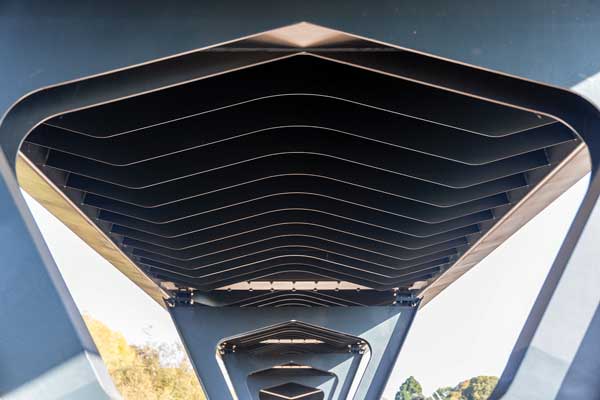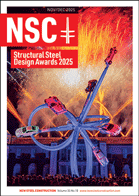SSDA Awards
AWARD – Kepax Bridge, Worcestershire
A new River Severn crossing in Worcester has created a sustainable commuting option for the city’s northern neighbourhoods.
FACT FILE
Architects: Moxon Architects Ltd
Structural engineer: Jacobs
Main contractor: Alun Griffiths (Contractors) Ltd
Client: Worcestershire County Council
Part of the local council’s commitment to deliver fully accessible, active travel infrastructure in locations that most need it, the Kepax Bridge provides a much-needed connection across the River Severn.
The 145m-long cable-stayed pedestrian and cycle bridge, which is named after the 19th Century Kepax Ferry that once operated nearby, is already a local landmark.
Its ‘hockey stick’ deck alignment allows the structure to integrate with riverside pathways, while elevating key sections of the bridge above flood-prone areas.
The bridge’s eastern approach begins in the historic Gheluvelt Park, where its deck initially parallels with the river before curving westward to span the Severn. Anchored by a 29m-tall, A-shaped pylon, the slender steel structure is supported by a series of cables (spaced at 12m intervals) and piers.
The fully fabricated form combines two simple elements into a dynamic composition that balances the forces at play.
Environmentally, the bridge is said to tread lightly over a sensitive landscape. It frames views without obstructing them, while at the same time, the pylon serves as a way marker, announcing the crossing from a distance.
One of the main challenges the project team had to overcome was gaining access to the site through the surrounding narrow residential streets. This was particularly complex given the scale of equipment involved — including a 1,000t-capacity mobile crane, several smaller cranes, a piling rig, and large steelwork deliveries.
Overcoming this challenge required meticulous advance planning and close coordination, supported by early public information events that kept the local residents informed.
“Structural steelwork was selected because it was well-suited to the segmental cantilever erection method used for constructing the bridge over the river,” explains Jacobs Principal Bridge Engineer James Hartland.
“All of the components were lifted in from above, with a small pontoon used to provide access for bolt tightening. This approach helped minimise disruption to recreational river traffic and protected the sensitive ecology of the area.
“Steelwork enabled faster and more flexible assembly of prefabricated elements, which were split into manageable pieces for delivery due to access constraints.”
The use of steelwork is said to have brought several other key benefits to the scheme. Its speed of erection helped shorten the construction programme and reduce associated risks, particularly important given the persistent threat of flooding.
The bridge’s components (holding down bolts, bearings, stay anchorages and steelwork) all had to be sufficiently safe from potential flood water, while maintaining an efficient but robust structural configuration.
The two asymmetric and perpendicular cable supported spans needed consideration both for the erection sequence (to ensure the structure remained adequately balanced and within geometry tolerances) and to resolve forces acting in differing planes into an optimal position for the backstay anchorage.
This required some careful steelwork detailing, particularly at the pylon head, which has a varying cross section.
Another benefit was the material’s adaptability, which allowed the fabricators to craft the steel sections into the required complex form. This geometry-driven design is shaped by numerous constraints, including current and future flood levels, gentle gradients and ecology. Steelwork enabled a refined structural form that responded to all of these in an elegant and efficient way.
Compared to concrete, steel posed fewer challenges related to time-dependent material and geometric changes, which is said to be a key consideration for a cable-stayed bridge.
The client’s brief for the bridge was to connect communities and encourage sustainable transport. As a public infrastructure investment, the design represents good value over its 120-year design life. It anticipates increased flooding due to climate change and it will remain resilient and operational even in the worst conditions.
With minimal interference to the sensitive river landscape, the structure uses traditional materials sparingly and robustly (concrete below flood level and steel above). The design, which includes a slender deck and an efficient structural configuration, is said to contribute to minimal embodied carbon.
Finished in a dark blue-green hue, the bridge mimics the palette of its natural surroundings, while its ribbed soffit highlights the structure’s sweeping geometry when viewed from below.
The 4m-wide crossing, which features a slip-resistant walking surface, has been designed to comfortably accommodate both leisure users and commuters. Meanwhile, a crafted parapet, composed of inward-leaning stainless-steel rods, provides safety for cyclists and pedestrians along the deck.
Subtle lighting balances safety with environmental impact as low-energy LEDs are integrated within the parapet. All of the bridge’s features will minimise operational carbon throughout the life of the bridge.
Councillor Marc Bayliss, Cabinet Member for Highways and Transport at Worcestershire County Council, says: “The bridge is iconic and the natural beauty of the city is really visible from it. The contractors did a fantastic job and I would like to say thank you to everyone who has made the vision a reality.
“It’s fantastic to see it already making a positive impact in the community as it provides an important new link for the city and helps reduce road traffic in the area.”
Summing up, the judges say, the sweeping mast-supported deck structure for this foot and cycle bridge visibly demonstrates its clear load paths at a suitable scale in the landscape. It is clearly well used in providing a new public crossing of the wide floodplain of the River Severn. ■





